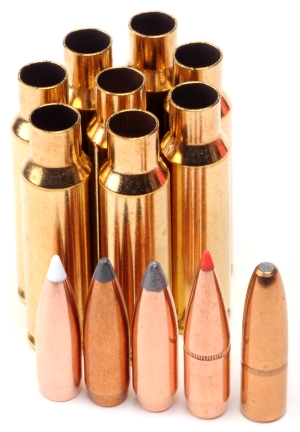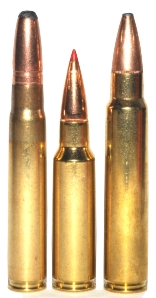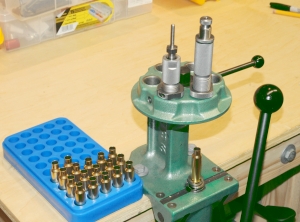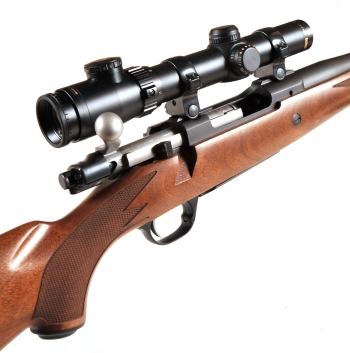
It takes a little time to figure out the personality of a cartridge before developing associated handloads. There was a time when my SOP was to load everything to maximum barrel frying velocity, with light to medium for bore bullets. It was certainly a simple process, but one that sometimes worked against the original intent of a cartridge and firearm combination.
The .338 Ruger Compact Magnum is a natural fit for short and medium range North American big game hunting. I would hazard a guess that with a .338″ bullet, 72 grains of gross powder capacity and a 20″ barreled rifle, a 400 yard shot at a running chipmunk was probably not at the forefront of the cartridge designer’s thinking. A two hundred fifty yard shot at an elk, or a hundred yard shot at a moose, or bear or big mule deer were all probably under serious consideration and this was the basis for what follows.
From tiny acorns, mighty…
As noted in Part I of this series, Hornady and Ruger define the .338 RCM by comparing its performance to the .338 Winchester Magnum, and underscored its benefits beyond the .338 Winchester Magnum by explaining it can deliver the same level of performance from a 20″ barrel, rather than the 24″ barrel typically associated with the older magnum. There are of course the ancillary .338 RCM benefits of: a lighter and more compact firearm, shorter action and bolt throw, lower cost ammunition and components, and just the right touch of “brand new” product. It’s a very good marketing approach. Winchester did the missionary work of educating the market on the benefits of the .338 Winchester Magnum and built good will through the sale of product. Hornady was then able to construct a .338 Winchester to .338 RCM analogy and leverage their product marketing efforts with the .338 Winchester Magnum’s popularity. I believe in racing that’s called drafting. In marketing circles, that’s called being smart.
The metric connection…
After spending some time shooting and handloading the cartridge, the .338 RCM proved to be very flexible and offers a good deal of potential for handloaders. The .338 RCM does not produce air scorching velocity, however, that does not preclude it from being a heavy hitter. In this regard, I think the .338 RCM does very well. I’ll draw some other cartridge comparisons.
 One of my favorite production rifles is a compact full stock bolt action, chambered for the 9.3x62mm Mauser. Pictured left, L-R: 9.3×62 Mauser, .338 RCM and the .338 RCM’s parent case, the .375 Ruger. The 9.3×62 is well respected by big game hunters for its ability to delivers lots of power, over short to medium ranges, with heavy bullets. Its 286 grain load performance
One of my favorite production rifles is a compact full stock bolt action, chambered for the 9.3x62mm Mauser. Pictured left, L-R: 9.3×62 Mauser, .338 RCM and the .338 RCM’s parent case, the .375 Ruger. The 9.3×62 is well respected by big game hunters for its ability to delivers lots of power, over short to medium ranges, with heavy bullets. Its 286 grain load performance  is often compared to the .375 H&H and almost every story of moose hunting in Finland begins and ends with the 9.3×62 Mauser. I decided to handload the .338 RCM with typical .338 Winchester Magnum 200 and 225 grain bullets, but also to try some of the heavier .338″ bullets and parallel some of the heavy 9.3×62 loads. At 78 grains, the Mauser holds only 6 more grains of powder than the .338 RCM. To that end, a Swift A Frame .338″ 275 grain bullet was added to the list of bullets slated for handloading.
is often compared to the .375 H&H and almost every story of moose hunting in Finland begins and ends with the 9.3×62 Mauser. I decided to handload the .338 RCM with typical .338 Winchester Magnum 200 and 225 grain bullets, but also to try some of the heavier .338″ bullets and parallel some of the heavy 9.3×62 loads. At 78 grains, the Mauser holds only 6 more grains of powder than the .338 RCM. To that end, a Swift A Frame .338″ 275 grain bullet was added to the list of bullets slated for handloading.
The Swift has a very high sectional density, which means lots of retained velocity and energy and enough inertia to assure bone crunching penetration. The Ruger Hawkeye’s 10″ twist rate is more than sufficient to stabilize this long bullet and this is the rate recommended by Swift Bullets. If handloads produced the velocity anticipated, the .338 RCM would have a flat shooting 180 grain bullet for mule deer, a collection of bullets for midrange for more heavy bodied game and a big 275 grain load that could paper punch a moose or bear…even in Finland.
Next to the red tipped Hornady 225 grain bullet, above, the Swift’s blunt ogive is obvious. However, because of the bullet length and gradual taper, the Swift A-Frame has a ballistic coefficient of .469 compared to the Hornady SST’s .430. The Swift has a two compartment “H” partition jacket, not unlike the Nosler Partition, and it’s tapered forward jacket thickness is not easily upset. The Hornady bullet is an excellent example of modern bullet making. The tip boosts the bullet’s BC, but is also active in controlled expansion. The one piece jacket has an internal Interlock ring, approximately half way up the bullet’s shank, that mechanically anchors the core to the jacket so it will stay put during expansion. There is, of course, a boat tail conclusion to provide lots of fuel for the “Does too” – “Does not” streamline effect debates. The Hornady will expand more fully while holding together over a wider velocity range. The Swift will barely expand below 2000 fps. Two very different bullets for two very different applications.
When in doubt, punt….
| Bullet | Weight Grains |
Length” | COL” | Net Cap. Grains |
Determining Factor |
| Nosler AccuBond | 180 | 1.232 | 2.756 | 60.5 | Minimum Seating Depth Rule |
| Sierra SPBT | 215 | 1.264 | 2.792 | 61.0 | Minimum Seating Depth Rule |
| Speer SPBT | 225 | 1.288 | 2.792 | 60.4 | Minimum Seating Depth Rule |
| Hornady SST | 225 | 1.441 | 2.835 | 57.8 | Magazine Box |
| Woodleigh PP | 250 | 1.293 | 2.835 | 60.6 | Magazine Box |
| Swift | 275 | 1.438 | 2.760 | 55.6 | Ogive – rifling clearance |
Case length for the .338 RCM is 2.015″ +0.0/-0.020″, trim to length is 2.005″. 2.845″ was used for a maximum COL. Bullet to rifling clearance was double checked with a Hornady modified test cartridge, COL gauge and bullet comparator.
Powder selection matters…
Powder testing and selection was interesting. I can’t remember a time when I ran across a cartridge that produced optimal results within such a very tight selection of products. I tried powders with similar burn rates, that generated similar peak pressures, that produced velocity variances greater than 150 fps. For the most part, Hodgdon had the best selection, particularly when tossing in their IMR brand. I think Alliant’s Re17 might have produced slightly better results than Re15, however, I didn’t have any on hand to verify and then current sources had the product on backorder. Spherical powder settled in without significant compression. Some of the extruded powder, particularly Re15 and H4350 were much more case filling.
I like Varget, but I could not get it to perform well with the .338 RCM. Velocity was significantly lower than anticipated even when tested against other valid sources of data. H414 did very well as did Re15. During all of the testing I encountered no flat primers, bright spots on case heads, separated cases, overly expanded case heads, sticking anything or soot covered brass. I wasn’t trying to squeeze the last handful of fps out of any of the loads, as it would be a colossal waste of time.
A good set of dies…
 Hornady New Dimension dies were selected for the project. I zip spindle decapper is a nifty features and I like the floating in-line sleeve in the seater die. I also figured Hornady designed the cartridge, which would help in the nuance dimension department. New Dimension seater dies are sold by caliber, not cartridge. So if you have a .338″ seater and you load for a variety of .338″ cartridges, you only need to buy the individual sizer dies and use the same seater die for all. The result is a $10 – $12 savings per common caliber cartridge reloaded. I’m like anyone else. I spend my money where it will do the most good.
Hornady New Dimension dies were selected for the project. I zip spindle decapper is a nifty features and I like the floating in-line sleeve in the seater die. I also figured Hornady designed the cartridge, which would help in the nuance dimension department. New Dimension seater dies are sold by caliber, not cartridge. So if you have a .338″ seater and you load for a variety of .338″ cartridges, you only need to buy the individual sizer dies and use the same seater die for all. The result is a $10 – $12 savings per common caliber cartridge reloaded. I’m like anyone else. I spend my money where it will do the most good.
When the dust settled…
External ballistics in summary…
|
Range |
Muzzle | 50 | 100 | 150 | 200 | 250 | 300 | |
|
Velocity |
||||||||
| Nosler AccuBond | 180 | 3094 | 2963 | 2836 | 2711 | 2590 | 2473 | 2358 |
| Sierra SPBT | 215 | 2797 | 2702 | 2610 | 2519 | 2430 | 2343 | 2258 |
| Speer SPBT | 225 | 2693 | 2600 | 2510 | 2421 | 2334 | 2249 | 2166 |
| Hornady SST | 225 | 2611 | 2509 | 2409 | 2311 | 2216 | 2123 | 2033 |
| Woodleigh PP | 250 | 2574 | 2481 | 2390 | 2310 | 2214 | 2129 | 2046 |
| Swift A-Frame | 275 | 2332 | 2244 | 2158 | 2075 | 1993 | 1913 | 1835 |
| Hornady Factory Load | 200 | 2852 | 2750 | 2650 | 2552 | 2456 | 2363 | 2272 |
| Hornady Factory Load | 225 | 2710 | 2605 | 2503 | 2403 | 2306 | 2211 | 2118 |
|
Kinetic Energy |
||||||||
| Nosler AccuBond | 180 | 3825 | 3509 | 3213 | 2938 | 2681 | 2443 | 2223 |
| Sierra SPBT | 215 | 3724 | 3486 | 3251 | 3029 | 2819 | 2621 | 2434 |
| Speer SPBT | 225 | 3623 | 3378 | 3146 | 2927 | 2721 | 2526 | 2343 |
| Hornady SST | 225 | 3405 | 3143 | 2898 | 2668 | 2453 | 2252 | 2064 |
| Woodleigh PP | 250 | 3677 | 3416 | 3170 | 2939 | 2721 | 2516 | 2324 |
| Swift A-Frame | 275 | 3320 | 3075 | 2844 | 2628 | 2424 | 2234 | 2056 |
| Hornady Factory Load | 200 | 3612 | 3357 | 3118 | 2892 | 2679 | 2480 | 2292 |
| Hornady Factory Load | 225 | 3670 | 3391 | 3131 | 2886 | 2657 | 2443 | 2242 |
|
Trajectory |
||||||||
| Nosler AccuBond | 180 | -1.5 | 0.5 | 1.4 | 1.3 | 0.0 | -2.6 | -6.6 |
| Sierra SPBT | 215 | -1.5 | 0.8 | 1.8 | 1.6 | 0.0 | -3.1 | -7.7 |
| Speer SPBT | 225 | -1.5 | 0.9 | 2.0 | 1.8 | 0.0 | -3.3 | -8.4 |
| Hornady SST | 225 | -1.5 | 1.1 | 2.2 | 1.9 | 0.0 | -3.7 | -9.3 |
| Woodleigh PP | 250 | -1.5 | 1.1 | 2.3 | 2.0 | 0.0 | -3.7 | -9.4 |
| Swift A-Frame | 275 | -1.5 | 1.6 | 3.0 | 2.5 | 0.0 | -4.7 | -11.8 |
| Hornady Factory Load | 200 | -1.5 | 0.7 | 1.7 | 1.5 | 0.0 | -3.0 | -7.5 |
| Hornady Factory Load | 225 | -1.5 | 0.9 | 2.0 | 1.8 | 0.0 | -3.4 | -8.6 |
Synapse crackle and pop…A retrospective
 Handloading was a snap. The .338 RCM case is easy to size, powder charges are reasonable to dispense, bullet seating is straight forward, and the short case runs through virtually any press with lots of room to spare. CCI Large Rifle Magnum primers on an APS strip were used in all loads, because I had a lot of them in bench stock and because I found no perceptible ballistic difference if I used a mixture of magnum and non-magnum primers. The .338 RCM uses the same shell holder as .375 H&H based cartridge #4 RCBS, #5 Hornady. Case expansion on firing was typical; virtually none at the case head, 0.006″ at the shoulder and 0.005″ in case length.
Handloading was a snap. The .338 RCM case is easy to size, powder charges are reasonable to dispense, bullet seating is straight forward, and the short case runs through virtually any press with lots of room to spare. CCI Large Rifle Magnum primers on an APS strip were used in all loads, because I had a lot of them in bench stock and because I found no perceptible ballistic difference if I used a mixture of magnum and non-magnum primers. The .338 RCM uses the same shell holder as .375 H&H based cartridge #4 RCBS, #5 Hornady. Case expansion on firing was typical; virtually none at the case head, 0.006″ at the shoulder and 0.005″ in case length.
A standard inertial bullet puller works with the .338 RCM, or at least a RCBS inertial puller works. One of my gripes with the WSM and Ultra Mag series is the inability to use anything other than a collet puller. Swift bullets seated right on their cannelure, just like the Hornady SST product. They will definitely bump rifling if seated out much farther. There is approximately 0.040″ rifling clearance at the COL indicated on the table above. The 180 grain Nosler Re15 load listed on the table is compressed…ramrod compressed, but not enough to puff out the brass.
Factory packaged Vs. custom load performance…
To get excellent performance out of a Ruger Hawkeye .338 RCM, all that is required is a box of Hornady 200 grain or 225 grain factory loaded ammo. The weights are appropriate for most .338″ applications, they performs as advertised and, at $35-$37 per box, ammunition isn’t over priced. Hornady has done a good job of loading maximum performance ammo, a handloader would have to make a real effort to match or exceed factory round performance for factory available bullet weights. The opportunities for the handloader are two fold. Cost – ammo can be reloaded, assuming amortizing the cost of brass over a dozen reloads, for approximately $10 – $12, or about one third of the cost of factory loaded ammo. Custom combinations – When you pick the components and assemble them, there can be lots of great bullets and powder combination that are not generally available.
Bang, bang…bang. Shooting and final impressions
 While the winter weather has been less than exciting, even living in this land of wells, septic tanks and self-reliance couldn’t put a damper on shooting the .338 Ruger Compact Magnum. Shooting took place during a few back to back clear days when temperature climbed into the high 2°F’s. No wonder Mainers excel at watching TV, snowmobiling and writing gothic horror stories.
While the winter weather has been less than exciting, even living in this land of wells, septic tanks and self-reliance couldn’t put a damper on shooting the .338 Ruger Compact Magnum. Shooting took place during a few back to back clear days when temperature climbed into the high 2°F’s. No wonder Mainers excel at watching TV, snowmobiling and writing gothic horror stories.
A chronograph was set up, a few targets were put out at the far side of a snow field and shooting was done from a solid rest. The Ruger had negligible recoil and muzzle blast from the short 20″ barrel was moderate, similar to a 24″ barreled gun. Even report was moderate. The Ruger remained well mannered throughout the day.
After firing a couple hundred rounds of factory and handloaded ammunition, my opinion of the rifle did not change. It remained easy to handle, quick to point and it fed live ammo and ejected empties without a hiccup. The times I used the hinged magazine feature, it worked as intended; unlatching and latching cleanly with positive engagement. The finish, both wood and metal, wiped clean and showed no signs of discoloration or wear and tear. The Ruger LC6 trigger pull was crisp and did not change in feel or pull over the duration of the project.
The 1.25-4×24 Bushnell Elite Scope was a good pick for this rifle and it provided more than adequate eye relief and magnification for the range session, as it would for Maine hunting. During days of live fire, bullet point of impact tracked precisely to adjustment and adjustment stayed put. Moving in and out of heated and very cold areas resulted in no fogging, internal or external. If I were hunting in an area of flatter topography and less dense woodland, I would probably bump up to a higher magnification variable, probably something from the Bushnell Elite 6500 series. The 180 grain through 225 grain loads certainly are flat shooting enough to take advantage of more glass if the conditions warranted.
Accuracy was consistent with other Ruger products we have incorporated into projects, excellent. To remove the 4x scope as a possible influence when determining group size potential, I swapped in a 16x scope and shot this part of the project between teeth chattering moments; see 2°F temperatures. Three shot groups were generally under 1½” for handloads, however, both Hornady SST and Nosler AccuBond bullets shot several several slightly less than 1″ groups. The smallest group was under ¾” and this was with Hornady factory 200 grain loads. I could not get Woodleigh 250 grain loads below 1¾”-2″, but I will tinker with this a bit more before publishing the specific and detailed handload data to the site.
Final thought – Very nice traditional American firearm, great value and a cartridge with very broad hunting applications. Congratulation are in order for Ruger and Hornady.
Ruger’s M77 Hawkeye Compact Magnum Part I
Ruger’s M77 Hawkeye Compact Magnum Part II

Email Notification